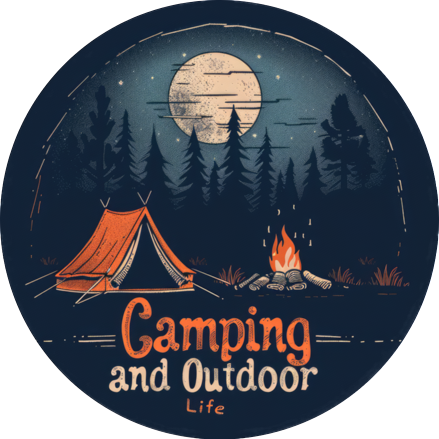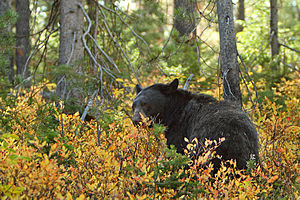
If you are planning a camping trip into bear country, it is important to educate yourself on the best ways to stay safe. Not only for you, but for the bear, as well. Remember, you are venturing out into their home and territory and learning the know how of what to and what not to do is essential. Not only for survival, but for respect and honor of the majestic animals and terrain that will welcome you into their home.
First, know your bears. In North America, there are two different types of bears. The black bear and the grizzly. Being able to differentiate between the two could save your life. Each has a very different personality and a very different way of being handled, should you encounter them.
Let’s start by comparing the two. Black bears are not always black. They can range from blonde to brown, as well. Usually, black bears are smaller than grizzlies, but this is not always the case. A juvenile grizzly can even be smaller than a black bear. So, determining the difference between the two cannot be done just using color and size alone.
The best way to differentiate the species is through looking at the head. A black bear will have a distinguishable difference between the forehead and the snout. Much like a Labrador Retriever. Whereas, the grizzly will have a near straight slope to it’s profile. Think of an English Pitt Bull Terrier. Also, a grizzly has a distinguishable hump at the base of the neck, extending into the shoulders. With this part being the most elevated of their stature. For the black bear, think again of a Lab. The shoulders and hind quarters will be near even, with the haunches slightly higher. Lastly, a grizzly will generally have, what looks to be, a main around their next. This is not so with the black bear.
If you should find yourself walking in the path of bear footprints, look at how far out the claw marks are. A grizzly will have claws extending, at least a couple inches beyond the toe pad, while the black bear has claws that extend about an inch. This is not to say that a black bear is any less dangerous, but your reaction to the two should be different, so pay attention. Take so time to observe a multitude of photographs of each do you best to feel confident that you can tell the difference.
Should you come into the path of either bear, first, try and determine if there are cubs around. Most altercations between humans and bears happen because a person comes between a sow, or female bear, and her cubs, or babies. If you see cubs, know that an attack is very possible and be ready to take a position of protection.

(Photo credit: Wikipedia)
It is important to note that black bears can climb trees, so seeking a tree for safety is not always the best option. A grizzly will rarely climb a tree, but it has happened. Just make sure that the tree is large enough and strong enough to support a climber for, at least, 14 feet into the air. It is not at all unusual for a grizzly to be able to reach heights of 12 feet or more, when arms are extended and standing on end.
If you see cubs, do not run. Do not scream. Try your best to back out of the area slowly, without turning your back. This may not advert an attack, but it can calm the mother enough to know you are not a threat. Should this not make a bear stand down, consider these tactics.
The best defense against either type of bear is bear spray. Bear spray is a concentrated pepper spray that disorientates the bear and can sting it eyes enough to effectively keep the animal and bay and on the run. It is crucial, however, that the spray not be deployed until the bear is, as least, within 30 feet of range. The closer the better. Any further and the spray will not has the desired potency or effect. In fact, bears are known to be drawn to the scent from a distance. It takes a considerable amount to stand your ground when a bear is charging, but it is the difference between sweet success and painful failure.
Many people think that a gun is a good way to take on a bear. In actuality, unless is it a big gun and you are a great shot, shooting at a bear can make a bad situation much, much worse. A bear is a huge animal that can weigh up to a half a ton or more. Mix that with some adrenaline and high powered speed and a bullet is hardly a match. Not only that, but the wild is a bear’s home and you are a guest there. Bears to not stalk people. They do not go looking for a fight with humans. They are shy, intelligent creatures and don’t deserve to face death because of a hiker’s inability to pay attention and use proper caution in their surroundings. That hardly seems fair. Instead, chose the pepper spray. The rate of success for survival is much, much higher anyway.

Making noise while hiking is another great way to alert a bear of your presence before it is too late. If a bear hears a human, chances are they will head the other way and fast. Many people like to hike with bells attached to their shoes, backpacks or walking sticks. While this constant jingling can be annoying, it is a good way to alert any bears of your presence from a good distance away. If a bell is not your style, sing, whistle or converse with one another. There is a place for silence in the woods, but that is not in bear country.
Should you find yourself without defense around a bear, try and stay calm and access the situation. Is the bear snorting? Standing on it’s hind legs? Scratching and stomping the ground at you? All of this? Get ready. If you are dealing with a black bear and cubs are not present, make yourself as big a possible. Roar! Shout! Be intimidating as possible. Bang together anything you can to make a loud sound. Do not drop eye contact. Do not run. Do not turn your back. Chances of scaring off the bear exist if it believes you are capable of harming it.
However, a grizzly is not the same. Never shout. Never make eye contact. Talk in a low, monotone voice or sing a lullaby. Do not turn your back. Do not run. Take tiny, bowing steps backward, all the while. Grizzlies cannot be intimidated by humans, so don’t even try.
If the attack is still coming at you, drop to the ground on your stomach. Cover your head with your arms. Always wear a backpack. Should the bear make contact, as hard as it may be, do not scream. Play dead. The bear doesn’t want to eat you. It sees you as a threat. If you are no longer a threat, chances are greater for your survival.
Most importantly, store your food and provisions in a bear safe environment. Many established campground have bear proof storage and garbage available at their tent camping sites. Store all food and toiletries inside the provided camp lockers and make sure that all garbage is put into the designated receptacles. Burning garbage in a campfire can be effective, but make sure the fire is hot enough to burn it all away. A bear has an incredible sense of smell and can sense a food source for up to a half mile away. Treat your toiletries the same. Bears are attracted to the scents of many lotions, hair care, deodorants and tooth paste.
If RV camping, still keep your food inside the vehicle and in the proper, closed containers. Keep the inside clean and don’t just leave food around. Although it is rare, bears have been known to break inside RV’s and tent trailers. Do not think that a cooler is enough to mask the scent of food. Never leave a cooler outside. When done preparing food, put the cooler back in the car or RV and make sure the windows are rolled up all the way. Tents will provide no protection, what so ever, so never leave a cooler , toiletries or food inside your tent. Also, while tent camping, it is best that all food is stored a good distance away from the tent, so keep that in mind. Pick up after yourself. Even the smallest crumbs can draw in a bear. Use a cleaner to wipe down eating surfaces and dishes, too.
If you are hiking in the back country, hang all food in a wrapped satchel, at least 15 feet up and 10 feet out from the trunk of a tree with rope. Then, make sure your campsite is established a good 30 feet away from the tree. If you are camping with animals, do the same with their food, too.
The best way to view bears is at a distance, so be aware of your surroundings. Be prepared with bear deterrents. Be knowledgeable about the types of bear and be careful and diligent with your food. Remember, bears are not out to get you. Don’t fear them, respect them and enjoy their place in our world.







